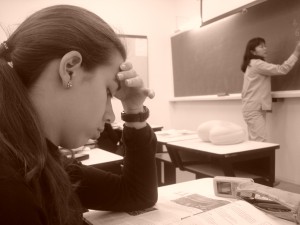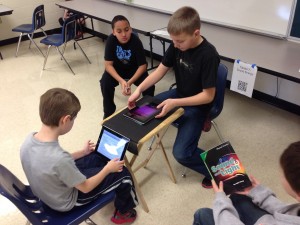Teachers: Apply to have your POPs be turned into web-based lessons!
Interested in using internet-based resources/tools/software in your teaching of PK-12 subject matter? Don’t have time or don’t know where to start?
Would you like your teaching to look more like the classroom on the left or the right? If you said you are inclined more the right-hand picture where students are exploring sound and recording an audio podcast, then read on…
Let Masters and Ph.D. students in the UTexas Learning Technologies program assist you in designing web-based teaching and learning plans specifically for a problem of practice (POPs) you identify, with the technological resources you have at hand in your school. Not only will you receive a lesson plan(s), but you’ll also receive a research-based rationale for why the plan will positively impact students’ learning.
Complete the following application by Jan 15, 2016 to secure review of your proposal by the class in late January 2016.
By applying you are agreeing that if chosen:
- You will try your hardest to be available via videoconferencing sometime b/w 4:00 – 7:00 PM (CST) on occasional Tuesdays: early February and on April 26 or May 3, 2016.
- You will be available to answer questions via email.
- The learning/lesson plans and research-based rationales will be distributed publicly free of charge with Creative Commons licensing.
AERA 2014 Presentations
Join us for our paper presentations at this year’s American Educational Research Conference in Philadelphia, PA.
Paper 1
Presenters: Joan E. Hughes, Michelle F. Read @MiShe11e, Sara J. Jones @sara_jones
Title of Paper: A Predictive Profile of Youths’ Web 2.0 Outside-School Activities
Day, Time, Location of Presentation: Saturday, April 5, 2:45-4:15 PM, Convention Center, Terrace Level, Terrace IV
Abstract: This quantitative study used multiple regression to identify predictors of middle school students’ Web 2.0 activities out of school, a composite variable constructed from 15 technology activities. Three middle schools participated in the study and 6th and 7th grade students completed an online survey. Independent predictor variables included school, gender, ethnicity, grade level, computer limits at home, assigned computer-based homework at school, total gadgets at home, Web 2.0 activities in school, traditional technology activities in school and three interaction variables. Results reveal a model explaining 25% of the variance, with statistically significant predictors including: school, ethnicity, grade, total gadgets, and the interaction of school and in-school Web 2.0 activities. Knowing what students do outside of school, and how in-school and out-of-school variables may impact such activity may assist educators in planning for technology in instruction and learning that both leverage what students are already doing or may wish they were doing, making learning motivating and connected to real life.
Paper 2
Presenters: Joan E. Hughes, Audrey De Zeeuw, Min Wook Ok
Title of Paper: Leadership and Vision in a High School 1:1 iPad Innovation in Practice
Day Time, Location of Presentation: Monday, April 7; 8:15-9:45 AM; Convention Center, Terrace Level, Terrace IV
Abstract: This research examines the school and district leadership practices, including setting direction, developing people, and making the organization work, in the first year of a 1:1 iPad innovation in practice at Hilly High School (HHS) in the southwestern United States. Participants included 6 district and 4 high school leaders. The study employed descriptive case study methodology with ethnographic elements including interviews and observations. Results depict a distributed leadership model across all leadership practices. Direction for the iPad innovation began with the superintendent’s noticing of a strategic planning technology gap, was solidified when leaders attended an Apple event, supported by a community valuing high achievement, and funded by the Board. Professional learning included short formal and a series of informal opportunities but overall was challenged due to budget cuts that reduced teachers’ time and technology integration support. Organizationally, infrastructural improvements to wireless networking were foremost. The district hired a mobile technology specialist mid-year to support integration efforts. Advisory input expanded to include pilot teachers, students, and a vision committee. Collaborations with the community were emphasized. This research reveals the importance of a distributed leadership network, a coherent yet flexible vision for the educational innovation, and openness and support for including new perspectives, such as from students and community members. Readers will need to generalize from the rich case description to their own contexts of practice or research.



